Click images for higher resolution

NITECORE HC50
LED: CREE XM- L2 T6 + 2× 5mm Red LED
Battery: 1× 18650 / 2x (R) CR123
Modes: 6 levels + 4 auxiliary modes, with memory.
Switch: Electronic "Two stage" switch
Date: December 2013
INTRODUCTION: 
NITECORE HC50
LED: CREE XM- L2 T6 + 2× 5mm Red LED
Battery: 1× 18650 / 2x (R) CR123
Modes: 6 levels + 4 auxiliary modes, with memory.
Switch: Electronic "Two stage" switch
Date: December 2013
The famous brand Nitecore has just launched its first dedicated headlamp, filling one of the major gaps that the brand had in his extensive catalog. This is the new Nitecore HC50, a headlamp devoted to a compact one-piece design that is powered by a rechargeable 18650 battery or two CR123 primary (or their counterparts rechargeable RCR) and provides two independent light sources.

The HC50 comes in a compact cardboard box similar to those we have seen before in the recent launches of the brand, in which we can see some of their specifications printed. Inside, the headlamp is accompanied by an elastic band with three-point restraint, a plastic bag with two spare o-rings in addition to the instruction manual in English and classical warranty card.


EXTERIOR FINISH:
The HC50 is built on a single block of aluminum, a similar construction to what we saw in the EA4. The benefits of this type of construction are primarily the higher robustness and improved passive heat dissipation.


Externally, the machining is sober but functional, being mostly a cylinder, except for the area where the optic headlight where Nitecore has machined some kind of heatsink with six fins.

The finish on the outer surface of the HC50 is sleek, HA III anodized matte black with several laser etched logos scattered on the smooth surface surrounding the heatsink. It has at its ends two caps, being the one that incorporates the switch sealed. The other cap is the one that can be disassembled in order to install the battery inside. Both caps feature a slotted side design that prevent the unit from rolling if we take it out of the rubber headband and we put on a smooth surface. Both also have a flat base which allows us to use the unit as a candle, if we want to dispense with the use of the headband.

The battery housing is located in an eccentric position inside the tube, in the area farthest from the optical end. Inside the battery housing, the positive contact is provided with a mechanism for protection against reverse polarity, which aside of its basic function, also prevent the use of "flat-top" batteries.

The negative contact is located on the front of the cap, and like the EA4 is rotatable and, to ensure proper alignment of the battery eccentrically positioned with respect to the total diameter of the unit, has a positioning pin. The threads are square-cut and come anodized, allowing block-out the light with just slight unscrewing them.


The main optics HC50, which provides white light with its XM-L2 T6 is small in diameter and shallow reflector, which will result in a beam of floody light, how couldn't be otherwise in a tool of this type. Glass lens with anti-reflective treatment, is secured by a small bezel. At both sides of the main optics are two small 5mm red LEDs red.

The elastic headband that accompanies the lamp is a new design, different from the other two Nitecore has marketed in the past as accessories.


The lamp unit is mounted on a piece of rubber with two brackets that hold the lamp properly embracing among the remaining flat areas on both sides of the sink and caps at both ends. The gummy material grips well aand support the anodized aluminum greatly, so the orientation is solidly attached. We can therefore guide the lamp by rotating within the brackets looking for the optimal angle depending on the use you are looking for.
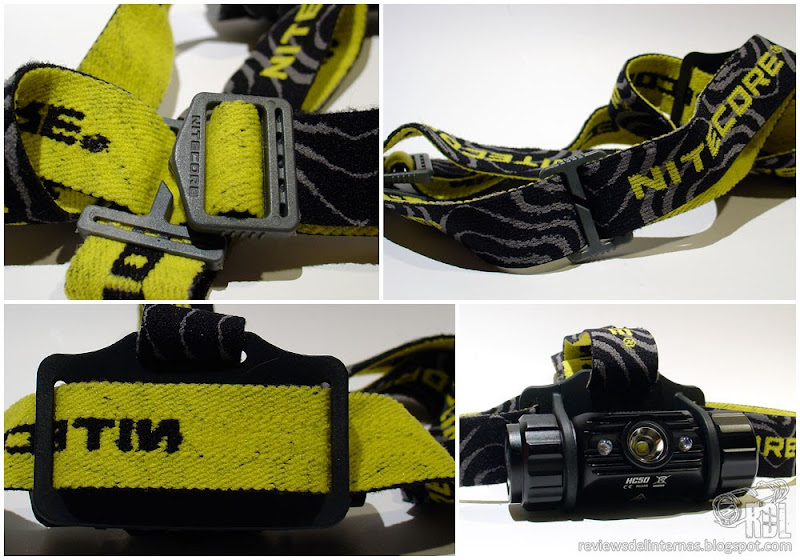
The elastic bands are a generous section with more 25mm wide, providing a considerable thickness and excellent elasticity. Thus the edge strip and the top have a sliding fit, allowing the headlamp to accommodate multiple head sizes. By the generous section and length of the wing, we can even install the front in a helmet with no size problems.
USER INTERFACE:
Nitecore has given the new HC50 with 6 different intensities, five of white light and an extra red light, plus 4 other auxiliary modes, three white light and one with red. The main sequence of modes is Lower, Low, Med, High and Turbo, all white light. The modes access is performed as follows:

White Light Main Modes: The HC50 uses a digital "two step" switch, called by Nitecore "Two Stage", similar to the trigger a camera that detects a full or partial press, which has already been used successfully in other flashlights of the brand, such as EA4. Turn on the flashlight by pushing the switch completely down (you'll hear click) and go alternating between the five main modes white light by partial pulses (slightly pressing the switch).
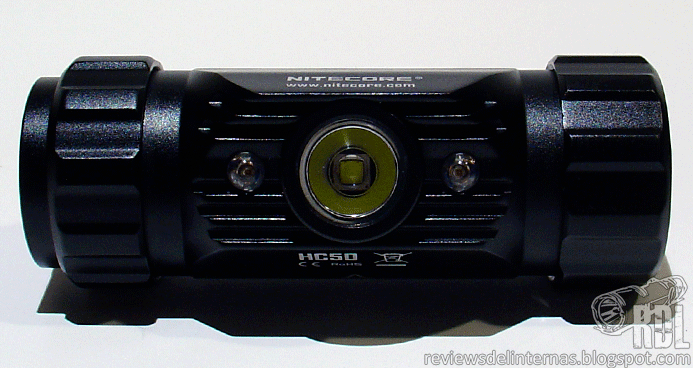
Red Light Modes: With the headlamp completely off, press the switch for two seconds and the HC50 will directly enter the red light illumination mode (1.2LM according to specifications from user manual). A slight touch on the switch will toggle to auxiliary mode red light, which is a slow signal / location strobe.
White Light Auxiliary Modes: With the headlamp on, do a quick double full press (ON-> OFF-> ON) to access the white light auxiliary modes. The first of the three auxiliary modes sequence is a slow strobe, a partial press will take us to the next, a beacon that emits a quick flash approximately every second, and repeating the partial press to enter the last auxiliary mode, an SOS that takes about 12 seconds to complete the full Morse sequence.
Finally, the HC50 incorporates an interesting function embedded in the switch. Under this silicone coating hides, as we saw in the EA4, a green backlight system that will tell us the battery voltage (or sum in the case we use two CR or RCR batteries) whenever we insert batteries on the headlamp. For example, if we insert a fully charged 18650 battery at 4.2V, once we fully threaten the cap the switch will issue four flashes, a pause and two flashes.
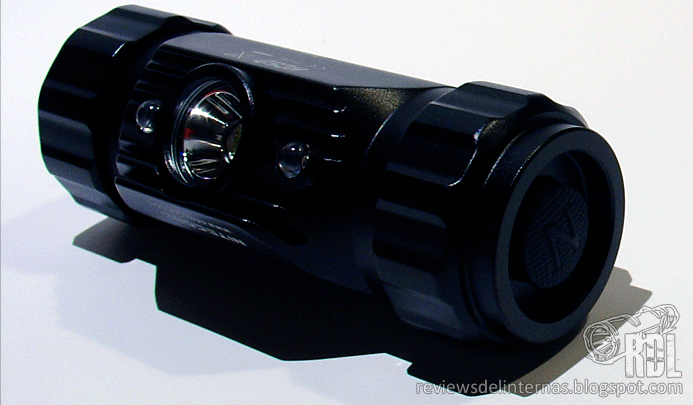
Moreover, as I have already mentioned above the HC50 can be locked by the thread block-out to avoid parasitic drain that is always present in this type of tools that lack a mechanical switch. After finding that current with a fully charged battery I get a figure of 0.170mA, which although not exceptionally low, will fully discharge a 3100mAh battery in more than two years.
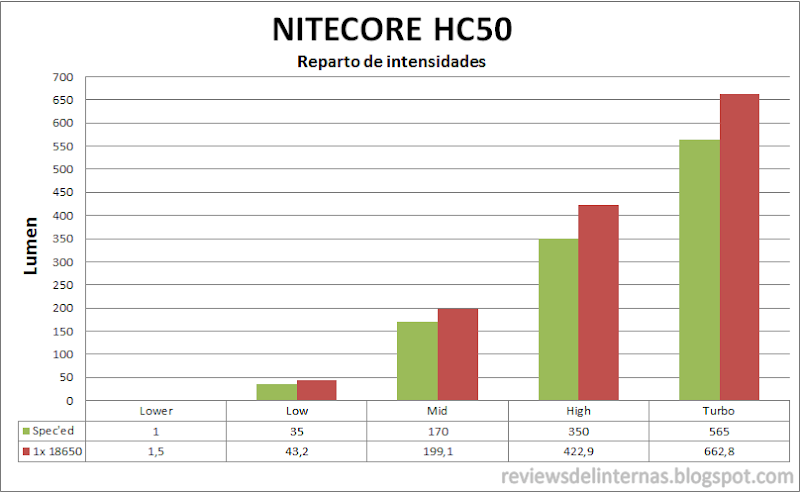
(All measurements are taken following the procedure ANSI NEMA FL1 using the value of the highest reading of between 30 and 120 seconds after start. More details in my ForoLinternas thread.)
We can see how the HC50 is spec'ed somewhat below what the integrating sphere measured output shows in his performance. Typically this sphere measurements, calibrated to reproduce the results of what Fenix specified in their products, determine in most cases that the actual performance is somewhat below the optimistic manufacturers specifications, which in this case is exception.
PERFORMANCE:
A very interesting thing that will surely be welcomed by the majority of this HC50 users is incorporating a temperature sensor system that automatically lowers the performance of the XM-L2 if the temperature exceeds 55 º C. As the instruction manual also mentions a timed stepdown at 3 minutes of continuous Turbo mode, I've decided to make a two-run test to see the behavior separately.
The first test in the integrating sphere I've done is without cooling (blue line), and for the second test, I used a small fan to keep the flashlight a few degrees cooler (red line) to tell the difference in the behavior of Turbo mode regulation:
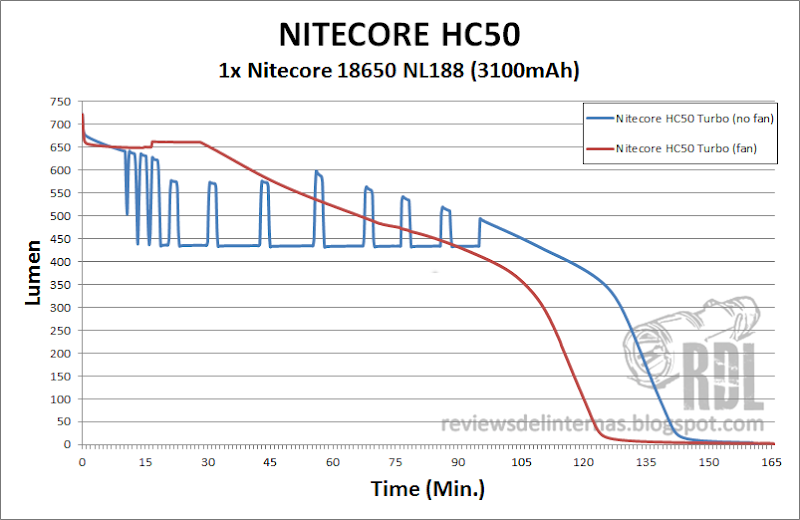
As you can see, the references to timed three minutes stepdown of continuous use must be an error, as there is no trace of this after the output is stabilized from initial start. What is obvious is the big difference between the two tests, with and without fan assist. The red line, corresponding to the fan assisted test shows an almost linear half hour regulation, which later starts a gradual decline (direct drive -like) to exceed two hours of use with still more than 100LM. The blue line, obtained by the test at ambient room temperature without fan assist, shows an interesting behavior of the headlamp, where after few minutes of continuous use begins to make some up and downs from Turbo to High mode to control the temperature of the unit. Interestingly, once the sensor detects that the temperature is low enough (according to the manual, below 55 ° c), the headlamp automatically returns to Turbo mode, increasing the performance and thus again generating more heat, so that the process starts again.
While it would have preferred a more linear temperature control, it seems a good move that surely will be improved in successive flashlights from this brand incorporating this system.
BEAM PROFILE:
When using a headlamp, it is logical not to look for a superb throw as the main use of these tools is to offer flood illumination that covers the area where our head is oriented. Thus, the small reflector, although smooth, featured on this HC50 offers clearly floody light, with a spill angle of 100 ° that although it doesn't offers a fully uniformly flood projection as we have recently seen in the Saprk SG5, comes close as blurs gently the hotspot covering a large area.

The XM- L2 T6 tint is cold, with some yellow hues in the corona which surrounds the hotspot, which goes as usual in this new generation XM-L2.

Another interesting detail to keep in mind in this HC50 is its output power, since the use of a one-piece aluminum construction gives it improved performance against some alternatives that use plastic in the construction of the headlamp unit passive dissipation, and is capable to offer ~600LM almost constantly whenever the ambient temperature is down to help keep the heat at bay.

Finally, it has surprised me the good beam offered by the two red LEDs, being classic 5mm encapsulated.
PERSONAL CONCLUSION:
Negatives: The main aspect of this improved HC50 is in the switch system. The feel of this is good for the partial press, but the full press requires more force. This means that sometimes the press fully to turn off the flashlight, especially if we didn't put the pressure from the exact center of the switch, the headlight will toggle modes by detecting pressure on the switch before you get completely off. This means that, having changed mode prior to the OFF, the light will memorize the next mode. After some handling practice is made easy, but it surely will annoy enough users starting to familiarize with this headlamp.
Another downside is that this circuit HC50, or rather this first batch of HC50 has a problem that some of you will be familiar with. This is the famous "Glowing LED" because the XM-L2 sometimes is not completely off, maintaining a very low glow when the flashlight should be off in standby. The truth is that you have to look pretty hard and be completely dark to notice. This ruling seems to have no fixed cause and after much break my head I managed to measure the current that this "Glowing LED" consumes about 0.60mA. Fortunately from what I've read Nitecore is replacing the units of this first batch showing this fault through its customer service.

Olight H15 Wave • Spark SG3 • Nitecore HC50 • 18650
Positives: For being the first foray into the field of high performance headlamps, I sincerely believe that Nitecore has entered with the right foot. The main feature that caught my attention positively on the HC50 is its simple and effective construction, both as improved robustness and dissipation. The modes are perfectly staggered, with a very usable low and powerful Turbo that, with low environmental temperatures as we have now offers great performance without having to be condemned to be cycling mode as in the tools completely controlled by timed stepdowns. The system voltage reading is extremely useful to avoid confusion if we charge more than one battery, and features a precision 0.1V reading, correctly rounded reading (3.96V = 4V, 3.9V = 3.94 V). The unit can be used even outside the elastic headband, and working as a flashlight that can be placed in different positions stable on any surface, thanks to the two flat surfaces of the ends or can even stand without rolling horizontally thanks to the slotted caps. To use two primary batteries also offers extra versatility because we can always include two of these primary batteries to our gear and have them as backup without worrying about its state of charge.
The elastic band provides outstanding quality, with an excellent fit for all sizes, or even to be installed in a helmet.
Nitecore HC50 sample provided by Nitecore.co.uk for review. Thanks!

